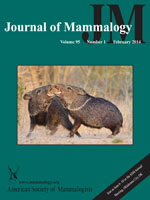Mammalian habitat specialists are suffering notable population declines and localized extinctions in response to climate change. Plastic behavioral responses, especially in foraging, may be critical for specialists to tolerate changes in temperature, precipitation, and resource availability. Here, we investigate the foraging behavior of a mammalian alpine specialist living in atypical habitat. American pikas (Ochotona princeps) are typically limited to high elevations in western North America; however, they persist near sea level in the Columbia River Gorge, well outside their previously assumed climatic niche. We hypothesized that utilizing unusual food resources contributes to pika persistence in this unusual climate. Moss comprised more than 60% of the diet at 2 sites, more than observed for any mammalian herbivore in the wild. Moss is available year-round in this habitat; thus, by specializing on moss, pikas do not have to construct large food caches to survive winter. These results suggest a larger degree of behavioral and dietary plasticity than previously assumed for this species. Understanding a species' capacity to adapt its foraging strategies to new resource landscapes will be essential to assessing its vulnerability to future climate change and to developing conservation plans.
How to translate text using browser tools
1 February 2014
Dietary plasticity in pikas as a strategy for atypical resource landscapes
Johanna Varner,
M. Denise Dearing
ACCESS THE FULL ARTICLE

Journal of Mammalogy
Vol. 95 • No. 1
February 2014
Vol. 95 • No. 1
February 2014
behavioral plasticity
Dietary specialization
foraging behavior
herbivore
moss
Ochotona
pika




